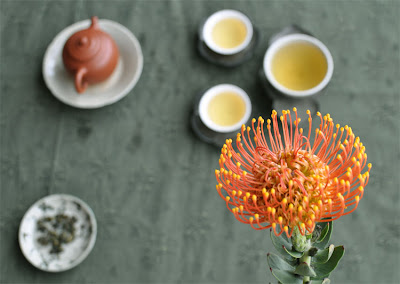Taiji chuan, yoga and most martial arts are a way for the mind to interact with the body ; meditation is a way for the mind to interact with the mind. It's a lot of calm and self reflection. This calm and peaceful feeling goes beyond what I had experienced with a session of gongfu cha. Even though drinking tea is already very relaxing, meditation goes even further, according to my short experience of several months. What is very interesting is that it's also possible to combine meditation and tea.
There are lots of different meditation techniques. The one I practice is as follows: I sit down on the floor, eyes open, and I count '1' in my head as I inhale, '2' as I exhale, '3' as I inhale... until '10' and then I start again, and I do this for 10-15 minutes. This may seem simple and boring, but it's amazing how difficult it can be to remain focused on breathing and counting. Lots of other thoughts try to surface and distract you! I find this exercise very beneficial to learn to enjoy the present moment.
As I have started to practice meditation, I have noticed that many readers and/or tea bloggers also meditate. I think that some of the benefits for tea making are obvious: a relaxed mind will prepare tea with greater care and focus. As one learns to live in the moment, we enjoy more the simple things in life, like a cup of tea. So, meditation before making tea helps to put us in a calmer, more receptive mood.
The goal is to continue to have an empty mind while making tea and not let any thought distract you. Today, I tried to continue to count to 10 during my gongfu cha, but found it difficult as I was handling the accessories. It was easier to do so during the brewing of the leaves, while waiting, but almost impossible while drinking from the cup. So many scents, tastes, feelings are happening all at once!
However, there was another good opportunity to meditate: after finishing the tea and placing the cup back on its saucer/tray. I enjoyed the finesse and strength of the aftertaste of my spring Ali Shan Oolong with much more detail and length. The pleasant effects on my palate and my body left a stronger impression. This is where I was glad I had picked an outstanding tea with a great character. With a fully conscious mind, the tea reveals itself, as it is.
Water shock
1 day ago


























































